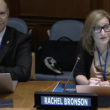Could incapacitating weapons become “everyday” weapons?
By Alan Pearson, March 18, 2008
All of the participants in this roundtable have identified states and their interest in incapacitating chemical weapons as the primary cause of concern regarding bioregulators and their chemical analogs. This may seem strange to readers in the United States where discussions of biological and chemical weapons overwhelmingly focus on terrorism. But my colleagues are right. Not only are states expressing interest in the developments Jonathan Tucker describes, which they believe will provide the basis for "usable" (i.e. useful and politically acceptable) chemical weapons, but only states have the capabilities needed to see the development of such weapons through from agent discovery to weapons deployment.
As Ralf Trapp points out, interest in incapacitating chemical weapons is not new. In fact, for nearly 60 years, advocates for such weapons have been able to convince funders that, because of advances in science and technology, "usable" incapacitating weapons are just around the corner. Yet somehow the promised incapacitants never seem to arrive. That today's scientific advances are enabling new ways of manipulating human physiology and brain function does not necessarily mean that new chemical incapacitants are any more likely to be "successful" than the old.
That said, Trapp's point that the mere possibility of "success" could suffice to stimulate research and development of new incapacitating chemical weapons has repeatedly been proven. Even more, the belief that researchers have developed an "acceptable" weapon could lead its use, as occurred in Moscow in 2002. For now, I am more concerned about these beliefs than I am about the possibility that a truly nonlethal incapacitating chemical weapon could be developed. The reason lies in the malleability of the concept of acceptability, which varies according to time, place, and context. I'm concerned that increased interest in incapacitants will generate pressures that lead to the use and proliferation of weapons that are deemed "good enough." In other words, if and when "success" comes, it may be due more to a redefinition of acceptability than to advances in science and technology. Then, the institutionalization, conventionalization, and marketization of the new chemical weapons (whereby they become more like small arms sold in the global market than like strategic weapons held by a restricted number of states) may well lead to an ever-expanding definition of acceptability, ever-broader range of uses, and a more powerful array of new and improved agents. (As a corollary, scientific debates about the likelihood that researchers can develop truly nonlethal chemical weapons will play a larger role in determining whether incapacitating weapons are developed and, especially, used than Trapp may grant.)
My colleagues also appear to agree that the States Parties to the Chemical Weapons Convention (CWC) must somehow set limits on the types and quantities of toxic chemicals that can be used for law enforcement, and ultimately must establish measures for monitoring and verifying compliance with these limits. But what limits, and how to set them?
Tucker proposes a "modest" first step–that States Parties declare their stocks of law enforcement chemicals and delivery systems. This could be useful if the declaration mechanism includes a specific definition of "law enforcement chemicals." Without a specific definition, States Parties could use the declaration mechanism to try to legitimize a wide and potentially open-ended range of chemicals for law enforcement purposes. An agreement to develop such a mechanism would provide a focal point for efforts to develop criteria, standards, and methods for determining whether a toxic chemical or delivery system is consistent with law enforcement purposes.
States Parties would have to address the central question raised by Trapp–what is the difference between prohibited and permitted chemicals? This question is really two questions: What actions qualify as law enforcement purposes under the CWC, and what characteristics of toxic chemicals are and are not consistent with such purposes? The first question relates to the hotly contested boundary between law enforcement and armed conflict, an issue that extends beyond the CWC. In the context of the CWC, the term clearly means more than domestic riot control. I believe that it means less than counterinsurgency operations, and that it excludes mixed combatant/noncombatant situations.
While complete resolution of this question within the CWC seems unlikely, even partial agreement would inform discussions of the second question, which falls squarely within the CWC. Nothing in the convention prevents States Parties from setting whatever criteria they collectively agree on, except that chemicals listed in Schedule 1 of the Verification Annex (like mustard and nerve gases) are definitely prohibited for law enforcement purposes. Some observers suggest that law enforcement chemicals be limited to those which meet the definition of riot control agents ("any chemical not listed in a Schedule, which can produce rapidly in humans sensory irritation or disabling physical effects which disappear within a short time following termination of exposure"). However, powerful States Parties, including the United States and Russia, are not inclined to agree.
Perhaps there is another approach. Law Professor David Fidler argues that, based on international human rights law, the more toxic a chemical is and the more difficult it is to control the effects of its use (i.e. to control the individual dosage received and/or the exposure conditions), the less likely that the chemical is of a type consistent with a legitimate law enforcement purpose. Might it be useful to incorporate the concept of controllability into the definition of law enforcement chemicals? For example, could they be defined as chemicals that produce "reliably controllable and temporary incapacitation which disappears within a short time following termination of exposure?"
Tucker proposes that the States Parties establish an advisory panel to explore the full range of relevant issues and provide a menu of policy options for regulating incapacitants. Such a panel could be the focal point for discussions leading to a declaration mechanism. Julian Robinson has suggested establishing an open-ended working group [PDF] with a mandate to develop guidelines for interpreting the law enforcement exemption, but not pursuing a declaration mechanism at this time. Whatever States Parties decide, they should begin a joint process of thoroughly examining Trapp's question. And whatever the outcome of this process, it should result in criteria, standards, and methods for determining whether a toxic chemical or delivery system is consistent with law enforcement purposes.
Topics: Biosecurity
Share: [addthis tool="addthis_inline_share_toolbox"]














